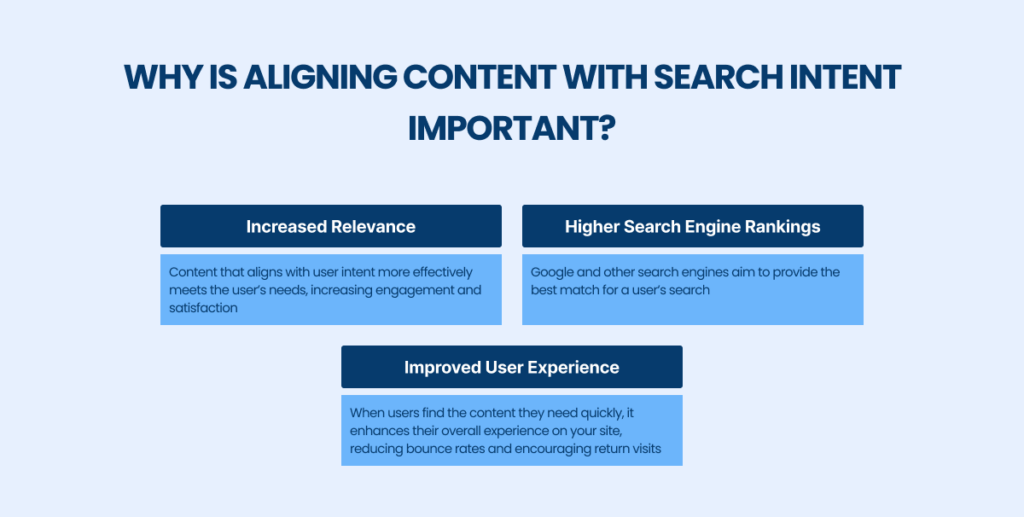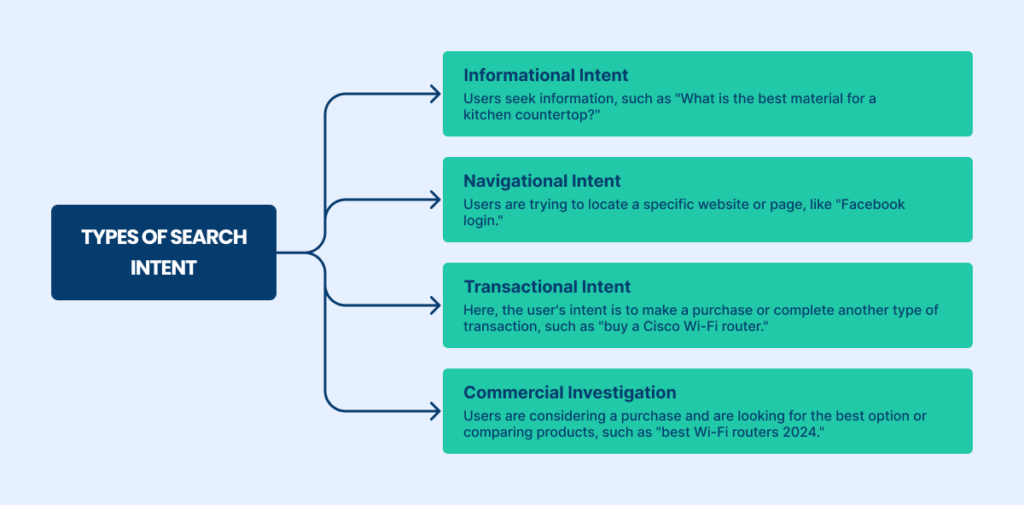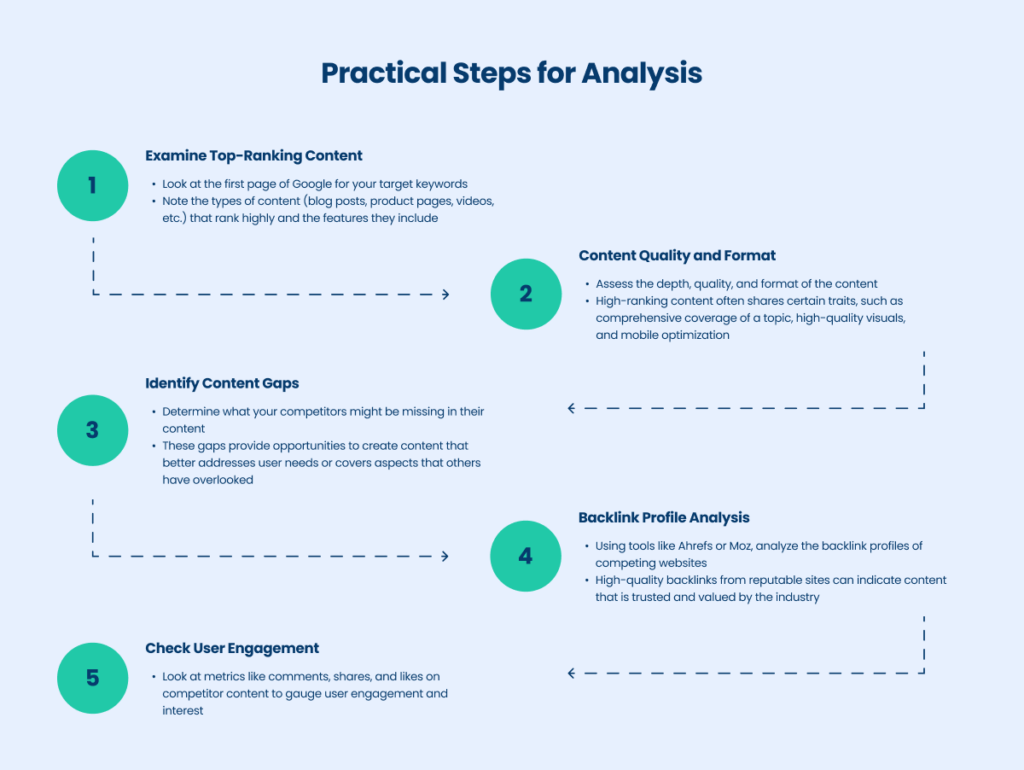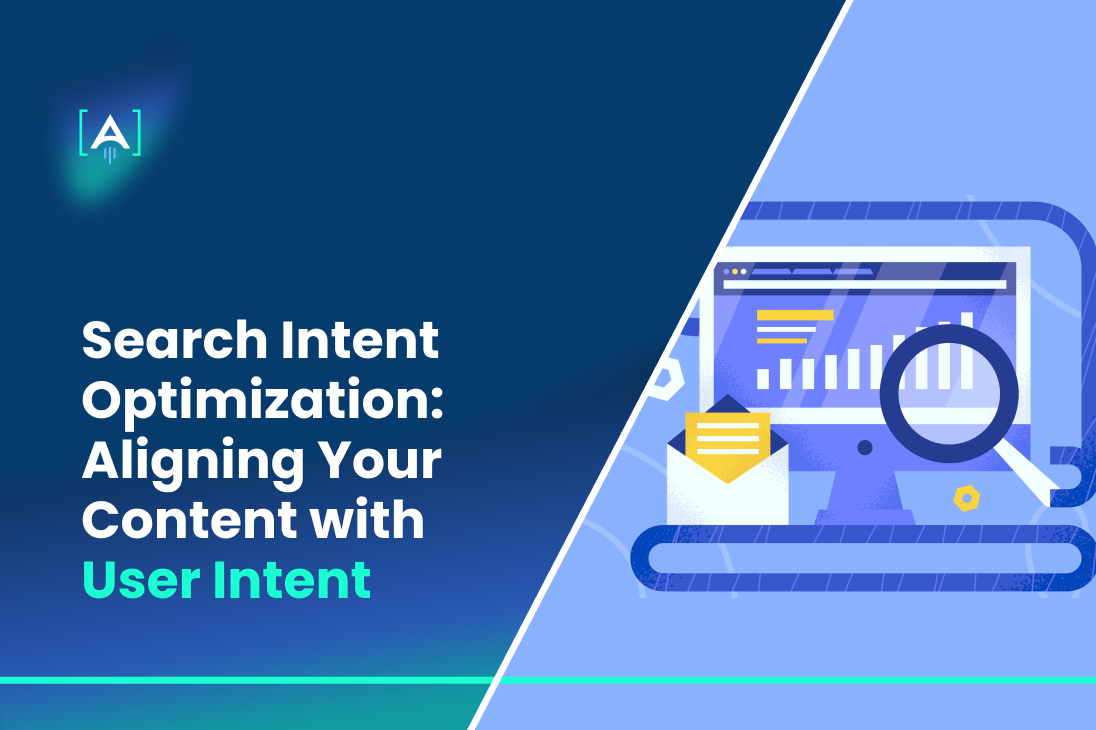In the ever-evolving landscape of SEO, mastering search intent optimization is crucial. But what is search intent? It’s the purpose behind every search query.
By aligning your content with the various types of search intent, you ensure relevance and precision, enhancing visibility on search engines.
Source: SemRush
From conducting competitor keyword research to refining local SEO strategies, understanding and implementing advanced search intent optimization can transform your approach, making every piece of content a targeted answer to a user’s specific needs.
An SEO Agency is critical in enhancing a business’s online presence and visibility.
The blog will introduce what search intent is and how to align the content for search intent.
Understanding What Is Search Intent
In the digital age, where millions of searches are conducted every second, understanding the intent behind these searches is crucial for any SEO strategy.
Search intent refers to the purpose or reason why a user conducts a specific search. Is it to buy something? To find a specific website? Or maybe to learn something new? Identifying this intent is critical to optimizing your content to meet those needs, which can dramatically affect your website’s visibility and user engagement.
Importance of Aligning Content with User Intent While Highlighting What Is Search Intent

How to Align Content with Search Intent
- Keyword Research SEO:
- Utilize tools like Google Keyword Planner or SEMrush to identify keywords that are relevant to your audience’s interests and needs.
- Look at the types of content that currently rank for these keywords to understand what users are likely to expect when they make these searches.
- Use of Google Search Console:
- Analyze the performance data in Google Search Console to see how users are finding your site and what queries they use.
- Adjust your content to match better the queries that are driving traffic.
- Competitor Keyword Research
- Study your competitors with tools like Ahrefs or Moz to understand their target keywords.
- Identify gaps in their content that you can fill to meet user needs better and draw traffic away from competitors.
- Optimizing for Local SEO:
- For businesses that operate locally, optimizing for local search intent is crucial. Ensure that your business is listed in local directories and Google My Business.
- Tailor content to include local landmarks, news, and events to increase relevance in local search results.
- Tailoring Content for Different Types of Intent:
- For transactional queries like “buy Cisco Wi-Fi router,” ensure that your content is straightforward and purchase-oriented, providing clear purchase options.
- For informational queries, provide detailed, valuable content, such as a blog post or a guide, that educates and informs the reader.
- Monitoring Tools and Trends:
- Stay updated with the latest in SEO and use advanced tools to track evolving search trends and user behaviors.
- Update your content regularly to keep it fresh and relevant and ensure it continues to align with changing search intents.
By strategically aligning your content with user intent, you enhance your site’s visibility and create a more engaging and effective online presence. This approach ensures that your audience finds exactly what they’re looking for, making your site a reliable resource in your industry.
Types of Search Intent
Understanding the types of search intent is pivotal in search intent optimization.
Search intent categorization helps tailor content strategies to match what users seek, enhancing user satisfaction and SEO effectiveness.

Informational Intent
When users have informational intent, they are primarily looking to learn something or gather information rather than make a purchase.
These queries are often questions or broad topics that don’t include commercial keywords.
Examples of Informational Queries
- How to reset a Cisco router—This query shows that the user is looking for specific steps to reset their device.
- What is SEO training – Here, the user wants to understand what SEO training involves.
- History of the Internet – This is a broader query seeking detailed information.
- Weather in New York today – A direct query looking for specific, timely data.
- SEO keyword cannibalization – This indicates a user seeking understanding about a specific SEO issue.
These examples highlight that users with informational queries are in the research phase, not yet ready to purchase or take action beyond gathering information.
Best Practices for Informational Content
Creating effective informational content requires a strategic approach that considers user needs and SEO best practices. Here are some key strategies to optimize informational content:
- Answer Questions Clearly and Concisely:
- Users looking for information appreciate direct and straightforward answers. Structure your content to answer questions early, preferably in the first few paragraphs, or use a FAQ format to address multiple queries clearly.
- Use Structured Data:
- Implementing schema markup can help search engines understand the context of your content, making it more likely to be featured in rich snippets or knowledge panels, especially for zero-click searches where users get their answers directly from the search engine results page (SERP).
- Create Comprehensive, Authoritative Content:
- Cover topics in depth to establish your site as an authority. Comprehensive content that satisfies user curiosity tends to perform better in user engagement and search engine rankings.
- Optimize for ‘People Also Ask’ Boxes and Featured Snippets:
- Since informational intent queries often trigger these features in Google, format and phrase your content in ways that are likely to be picked up for these SERP features. Using question-based subheadings and bullet points can help achieve this.
- Avoid SEO Keyword Cannibalization:
- Ensure that multiple pages on your site do not compete for the same keywords. This practice dilutes your SEO efforts and can confuse search engines about which page to rank for a query. Each piece of content should target a unique aspect of a topic.
- Link to Additional Resources:
- Providing links to related content can keep users engaged and offer them more value while improving your site’s SEO through effective internal linking.
- Optimize Content Regularly:
- The needs of users can evolve, as can the accuracy of information. Regular updates to your content ensure it remains relevant and useful, maintaining its authority over time.
- Design an Engaging SEO Training Landing Page:
- For topics like “SEO training,” where users might eventually be interested in courses, create a landing page that provides information and guides visitors to take a course or contact you for more training.
- Monitor Performance with Analytics Tools:
- Use tools like Google Analytics and Google Search Console to track the performance of your informational content. To understand user engagement and satisfaction, look at metrics like page views, average time on page, and bounce rates.
By focusing on these best practices, you can effectively cater to informational intent and improve the overall effectiveness of your SEO strategy.
This ensures that users not only find your content but also find it incredibly valuable. This approach satisfies search intent and positions your website as a go-to resource in your niche.
Navigational Intent
Navigational intent is a critical aspect of search intent optimization focusing on users with a specific destination.
Source: Semrush
Unlike informational or transactional searches, navigational queries are entered to find a particular website or page. Understanding and optimizing for this type of intent is essential because it captures users already familiar with a brand or service and looking to engage directly with it.
Examples of Navigational Queries
Navigational queries are typically straightforward because the user knows exactly where they want to go. Here are some examples:
- “Facebook login” – The user wants to find the login page for Facebook.
- “OpenAI blog” – The searcher is looking to access the blog section of the OpenAI website.
- “Amazon customer service” – This indicates the user needs the customer service page of Amazon.
- “New York Times current events”—The user is specifically interested in the New York Times’ current events section.
- “YouTube trending videos” – The query aims to find the trending videos section on YouTube.
These examples show that users are not looking for information about the sites or pages but rather trying to reach them directly. Therefore, the primary goal in optimizing for navigational intent is to ensure that users can find your site or specific pages easily and quickly.
Tips for Optimizing Navigational Content
Optimizing for navigational intent involves several strategic actions designed to enhance the visibility and accessibility of specific pages or websites. Here are effective tips to optimize navigational content:
- Ensure Brand Visibility in Search Engines:
- Use Brand Keywords: Ensure that your website is optimized for your brand name and any other relevant brand-related keywords. This includes including your brand name in the title tags, meta descriptions, and throughout the content where appropriate.
- Claim Your Google My Business Listing: For local businesses, having a well-maintained Google My Business profile can significantly improve their visibility in navigational searches.
- Optimize Website Structure:
- Clear Navigation: Your website should have a clear, logical navigation structure that makes it easy for users to navigate. This includes a prominent menu with direct links to important pages.
- Breadcrumb Navigation: Implementing breadcrumb links on your pages helps users understand their location within your site and how to navigate to higher-level pages easily.
- Enhance Page Load Speed:
- Users with navigational intent usually expect quick access to specific pages. Ensure your website pages load quickly to reduce bounce rates and improve user satisfaction. Tools like Google PageSpeed Insights can be invaluable in identifying and remedying slowdowns.
- Use Strategic Internal Linking:
- Use strategic internal linking to guide users to your most important pages. This helps with SEO and improves the user experience by making relevant pages more accessible.
- Focus on Mobile Optimization:
- With the increasing prevalence of mobile searches, ensuring that your mobile site is optimized is crucial. Mobile users should be able to navigate your site and find what they need without any hindrance.
- Implement Schema Markup:
- Use schema markup to help search engines understand the content of your pages better. This can lead to enhanced displays in SERPs (Search Engine Results Pages), making it easier for users to identify and click on your link.
- Monitor and Analyze Traffic:
- Monitor your website’s traffic regularly using tools like Google Analytics to see how users are finding your site. Pay special attention to the performance of pages that are likely targets of navigational searches and adjust your strategies as needed.
- Maintain Consistency in Brand Messaging:
- Consistent use of your brand name, logo, and taglines across your website and in your marketing materials can reinforce brand recall, making it easier for users to remember and search for your site directly.
By effectively optimizing for navigational intent, you ensure that users looking specifically for your brand or website can find you effortlessly.
This is a crucial part of search intent optimization, as it directly impacts user experience and satisfaction, ultimately influencing your site’s traffic and engagement levels.
Transactional Intent
Transactional intent is a core category in search intent optimization, crucial for businesses looking to convert visitors into customers.
Users with transactional intent are ready to make a purchase or engage in another type of transaction. Understanding and catering to this intent can significantly enhance a business’s ability to capture ready-to-buy users and increase conversions.
Examples of Transactional Queries
Transactional queries are direct and often include specific action words or phrases indicating purchase readiness. Examples include:
- “Buy Cisco Wi-Fi router” – This user wants to make a purchase immediately.
- “Subscribe to Netflix” – Indicates the user’s intent to start a subscription service.
- “Book a flight to New York” – The user is ready to book travel.
- “Nike Air Max sale” – Search for specific products on sale.
- “Download Photoshop” – Shows intent to purchase or subscribe to software.
These queries demonstrate a clear intent to engage in a commercial activity, and thus, content optimized for these queries should facilitate the transaction process.
Strategies for Transactional Content
Businesses need to implement specific content strategies to effectively target transactional intent. These strategies must attract users and convert their intent into action.
- Clear and Compelling Calls to Action (CTAs):
- Use strong, action-oriented CTAs like “Buy Now,” “Subscribe Today,” or “Add to Cart.” These should be prominently displayed and easy to find.
- Optimize Product and Landing Pages:
- Ensure that product descriptions are detailed, benefits-focused, and keyword-optimized to meet search criteria.
- Include high-quality images and videos to showcase the product effectively.
- Pricing should be clear, and discounts or special offers should be prominently displayed.
- Simplify the Checkout Process:
- Reduce the number of steps required to complete a transaction. A straightforward checkout process minimizes the chances of cart abandonment.
- Offer multiple payment methods to cater to different preferences.
- Use Urgency and Scarcity:
- Techniques such as limited-time offers or limited stock notifications can create a sense of urgency that encourages users to act quickly.
- Trust Signals:
- Display security badges, return policies, and customer testimonials prominently. These elements build trust and reassure potential customers about the safety and reliability of transacting with your site.
- Mobile Optimization:
- Ensure that transactional pages are optimized for mobile devices, considering a significant portion of users shop on smartphones and tablets.
- SEO Best Practices:
- Implement schema markup for products and reviews to enhance visibility in search results.
- Regularly update content and ensure that SEO basics like meta descriptions and title tags are compelling and keyword-rich.
Commercial Investigation
Users exhibiting commercial investigation intent are in the research phase of their buying journey.
They compare products, read reviews, and look for the best options before purchasing. This intent is crucial for businesses to understand as it represents a potential customer who is very close to making a purchase.
Examples of Commercial Queries
Commercial queries often include comparisons or specific details about products or services. Examples include:
- “Best DSLR cameras 2024” – Comparing current market offerings.
- “iPhone 12 vs. Samsung Galaxy S21” – Looking for a direct comparison to decide between two products.
- “Top-rated dishwashers under $500” – Seeking the best options within a specific budget.
- “Reviews of Honda Civic” – Looking for user experiences and expert opinions.
- “Features of Google Workspace plans” – Researching different service tiers to find the most suitable one.
How to Cater to Commercial Intent
Optimizing content for commercial intent involves providing comprehensive, comparative, and detailed content that assists users in making informed purchase decisions.
- Create Comparative Content:
- Develop detailed comparison guides highlighting the pros and cons of various products or services. Use tables, lists, and bullet points to make the information easily digestible.
- In-depth Product Reviews:
- Offer thorough reviews that describe features and benefits and provide real-use cases and personal experiences to give a well-rounded view.
- SEO Optimization for Comparative Keywords:
- Include common comparative phrases and keywords in your content to capture more of this search intent.
- Optimize headers and subheaders with questions and keywords that users might use when looking to compare products.
- User-Generated Content:
- Encourage and facilitate the submission of user reviews and ratings. This provides social proof and enriches your content with additional keywords and varied perspectives.
- Educational Content:
- Provide educational content that helps users understand what features or attributes they should consider when deciding. This builds trust and positions your site as a helpful resource.
- Use of Rich Snippets:
- Implement structured data to help search engines display more information directly in the search results, such as star ratings, price ranges, and availability, which are crucial for users in the commercial investigation phase.
By thoroughly addressing both transactional and commercial investigation intents, businesses can effectively guide potential customers through their decision-making process, increasing the likelihood of conversions from users who are ready to buy.
Tools and Techniques for Identifying User Intent
In digital marketing, identifying user intent is fundamental for crafting targeted, effective content that meets potential customers’ needs.
Understanding what users are searching for—and why—allows businesses to optimize their strategies in alignment with actual user behaviors and preferences.
Keyword Research Tools
Keyword research is the cornerstone of search intent optimization. It involves identifying the keywords and phrases that potential customers use in search engines.
This insight helps shape content, SEO, and overall marketing strategies to meet user needs better and improve search engine visibility.
Features of Leading Tools
Leading keyword research tools offer a variety of features that help marketers understand search intent more accurately:
- Search Volume Analysis: This feature provides data on how many times a keyword is searched per month, which helps gauge its popularity and relevance.
- Keyword Suggestions: Tools often suggest related keywords, which can help expand the scope of content and SEO strategies to cover more potential search queries.
- SERP Analysis: Some tools allow users to analyze the search engine results pages (SERPs) for specific keywords, offering insights into which types of content are currently ranking and why.
- Competitor Keyword Analysis: By understanding which keywords competitors are targeting, businesses can identify gaps in their own strategies and find opportunities for improvement.
- Intent Indicators: Advanced tools categorize keywords by intent (informational, navigational, transactional, etc.), helping marketers tailor their content appropriately.
Popular tools like Google Keyword Planner, SEMrush, Ahrefs, and Moz provide robust functionalities that cater to these needs, making them indispensable in the toolkit of a digital marketer.
Analyzing Search Results and Competitor Content
Analyzing search results and competitor content is crucial for understanding the context in which keywords are used and how other businesses meet user needs (or fail to meet).

Using Analytics to Understand User Behavior
Web analytics tools like Google Analytics offer a treasure trove of data about how users interact with your site. This data can provide deep insights into user intent and behavior, guiding more informed decisions about content and SEO strategies.
Key Metrics to Watch
- Bounce Rate: High bounce rates can indicate that a page’s content does not align well with the user’s search intent. Analyzing bounce rates by page can help identify where content may not meet user expectations.
- Pageviews and Time on Page: These metrics help measure your content’s attractiveness and engagement level. More time spent on a page generally indicates relevant and interesting content to visitors.
- Conversion Rates: Tracking the number of visitors who complete a desired action (like filling out a form or making a purchase) can indicate how well the content aligns with transactional intent.
- Path Analysis: Understanding users’ paths through your site can reveal a lot about their intentions and whether your site structure effectively guides them to their goals.
- New vs. Returning Visitors: The ratio of new to returning visitors can provide insights into whether your content is compelling enough to bring users back.
By leveraging these tools and techniques, businesses can understand user intent comprehensively, which is critical for optimizing content and improving overall online engagement.
Each method provides a different perspective on what users want and how they interact with online content, offering a detailed roadmap for improving content strategies to better satisfy user needs.
Partner with [A] Growth Agency for the Right Search Intent Optimization
Search Intent Optimization is the essential method for the right SEO strategy. By aligning content with the correct search intent, companies can significantly improve their visibility and ranking on search engine results pages (SERPs). [A] Growth Agency will clarify all the essentials for your business.
We know what the best solution for your products is. Our team of top-tier professionals brings expertise and creativity. Every business we work with is a partner. We’re invested in their success as deeply as our own, fostering a mutual growth journey.
If this is what you are looking for, then we are here.

